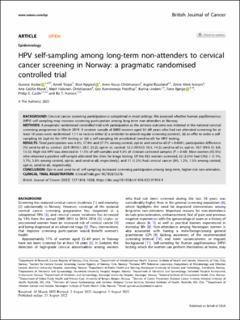| dc.contributor.author | Aasbø, Gunvor | |
| dc.contributor.author | Trope, Ameli | |
| dc.contributor.author | Nygård, Mari | |
| dc.contributor.author | Christiansen, Irene Kraus | |
| dc.contributor.author | Baasland, Ingrid | |
| dc.contributor.author | Iversen, Grete Alræk | |
| dc.contributor.author | Munk, Ane Cecilie Dæhli | |
| dc.contributor.author | Christiansen, Marit Halonen | |
| dc.contributor.author | Presthus, Gro Kummeneje | |
| dc.contributor.author | Undem, Karina | |
| dc.contributor.author | Bjørge, Tone | |
| dc.contributor.author | Castle, Philip E. | |
| dc.contributor.author | Hansen, Bo Lars Thorvald Terning | |
| dc.date.accessioned | 2023-05-04T08:31:16Z | |
| dc.date.available | 2023-05-04T08:31:16Z | |
| dc.date.created | 2022-09-06T11:30:21Z | |
| dc.date.issued | 2022 | |
| dc.identifier.citation | British Journal of Cancer. 2022, 127 (10), 1816-1826. | |
| dc.identifier.issn | 0007-0920 | |
| dc.identifier.uri | https://hdl.handle.net/11250/3066120 | |
| dc.description.abstract | Background Cervical cancer screening participation is suboptimal in most settings. We assessed whether human papillomavirus (HPV) self-sampling may increase screening participation among long-term non-attenders in Norway. Methods A pragmatic randomised controlled trial with participation as the primary outcome was initiated in the national cervical screening programme in March 2019. A random sample of 6000 women aged 35–69 years who had not attended screening for at least 10 years were randomised 1:1:1 to receive either (i) a reminder to attend regular screening (control), (ii) an offer to order a self-sampling kit (opt-in) for HPV testing or (iii) a self-sampling kit unsolicited (send-to-all) for HPV testing. Results Total participation was 4.8%, 17.0% and 27.7% among control, opt-in and send-to-all (P < 0.0001; participation difference (%) send-to-all vs. control: 22.9 (95%CI: 20.7, 25.2); opt-in vs. control: 12.3 (95%CI: 10.3, 14.2); send-to-all vs. opt-in: 10.7 (95% CI: 8.0, 13.3)). High-risk HPV was detected in 11.5% of self-samples and 9.2% of clinician-collected samples (P = 0.40). Most women (92.5%) who returned a positive self-sample attended the clinic for triage testing. Of the 933 women screened, 33 (3.5%) had CIN2 + (1.1%, 3.7%, 3.8% among control, opt-in, and send-to-all, respectively), and 11 (1.2%) had cervical cancer (0%, 1.2%, 1.3% among control, opt-in, send-to-all, respectively). Conclusion Opt-in and send-to-all self-sampling increased screening participation among long-term, higher-risk non-attenders. | |
| dc.language.iso | eng | |
| dc.title | HPV self-sampling among long-term non-attenders to cervical cancer screening in Norway: a pragmatic randomised controlled trial | |
| dc.title.alternative | HPV self-sampling among long-term non-attenders to cervical cancer screening in Norway: a pragmatic randomised controlled trial | |
| dc.type | Peer reviewed | |
| dc.type | Journal article | |
| dc.description.version | publishedVersion | |
| dc.source.pagenumber | 1816-1826 | |
| dc.source.volume | 127 | |
| dc.source.journal | British Journal of Cancer | |
| dc.source.issue | 10 | |
| dc.identifier.doi | 10.1038/s41416-022-01954-9 | |
| dc.identifier.cristin | 2049152 | |
| cristin.ispublished | true | |
| cristin.fulltext | original | |
| cristin.qualitycode | 2 | |
